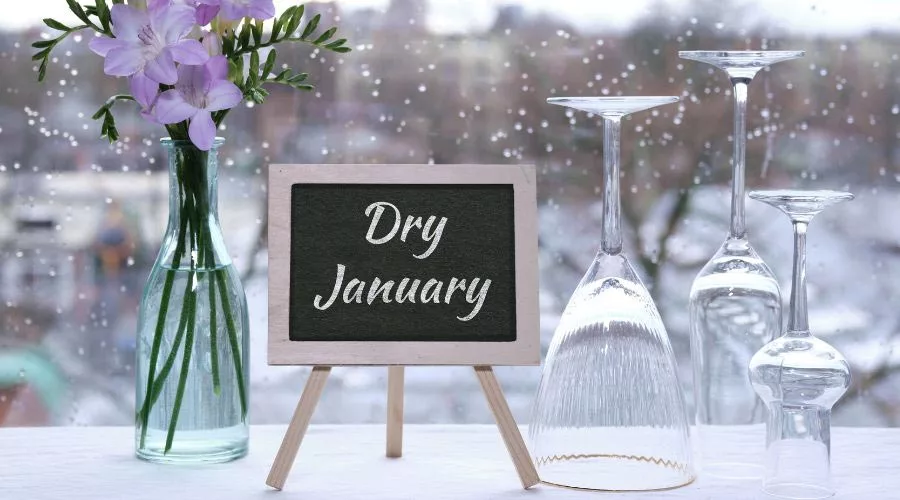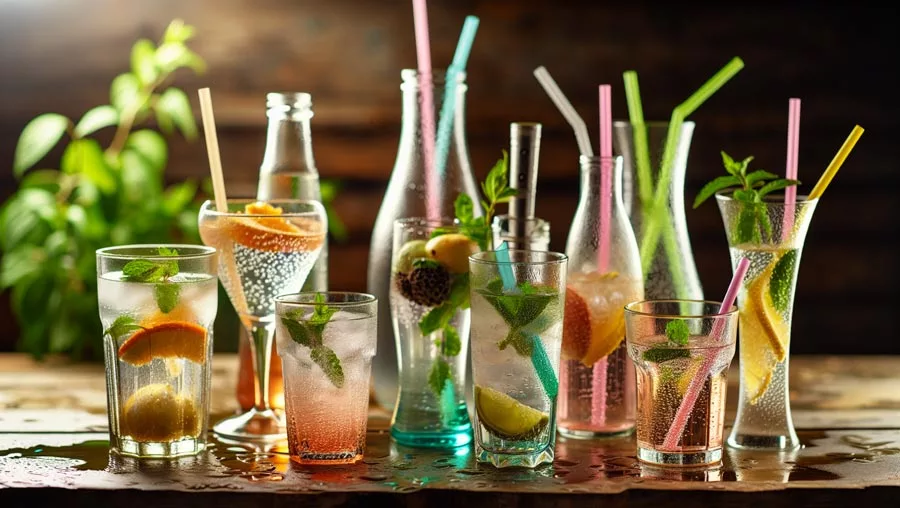Dry January Tips: 15 Ideas for a Refreshing Month Sober

Welcome to 2024! As the new year dawns, many of us will be setting goals for self-improvement and starting a list of various resolutions and ‘resets’. For some, this may include Dry January – a month-long break from alcohol that can kick-start a year of healthier habits and even serve as an introduction to a life lived sober.
But how can you ensure success in this endeavor and reap the benefits such as better sleep, more energy, and weight loss? The answer lies in following this, our latest blog resource from SOBRLIFE Clothing! It’s chock full of Dry January tips like ways of better setting clear goals, creating a supportive environment to sustain your efforts, and discovering non-alcoholic alternatives worth drinking.
Without further ado, let’s get ready to have a blast this January, without the booze!
Embracing the Dry January Challenge: Tips from SOBRLIFE Clothing
Dry January signifies more than a simple break from alcohol; it can often symbolize the beginning of a healthier lifestyle. Allow SOBRLIFE Clothing to be your guide on this transformative journey. Based in Delray, Florida, SOBRLIFE Clothing is a sober clothing line committed to supporting individuals on their path to sobriety. Their apparel acts as a tangible reminder of your commitment and serves as a source of inspiration during your Dry January journey.
In addition to their stylish and meaningful apparel, SOBRLIFE Clothing also offers valuable advice and resources on our regularly updated blog to help you conquer the Dry January challenge with ease. They recommend connecting with a community of like-minded individuals, drawing inspiration from sober apparel, and committing to a healthier lifestyle free from alcohol.
Wearing SOBRLIFE Clothing not only aligns with your sober goals but also makes a statement about your commitment to a healthier lifestyle, reminding you of the benefits of a sober lifestyle and providing an extra boost of motivation during the entire month of Dry January.
3 Ways of Setting Your Dry January Goals
As you prepare to undertake your Dry January journey, make sure to establish clear goals. But how can you ensure these goals are effective and tailored to your needs? Here, we’ll guide you through the process of defining your ‘why’, visualizing your success, and measuring your progress.
These steps, based on the tried-and-true SMART Recovery approach, will help you set goals that are:
- Specific
- Measurable
- Attainable
- Relevant
- Time-bound
By following these steps, you can create goals that are unique to you and increase your chances of success.
We’ll delve further into each of these areas.
1) Defining Your ‘Why’
Defining your ‘why’ is the cornerstone of your Dry January journey. This means identifying your reasons for participating in Dry January, such as enhancing work focus, redefining life goals, or even losing weight. Your ‘why’ acts as a strong motivator, helping you stay focused and driven even when faced with challenges.
If heavy drinking is a challenge for you, a consultation with your doctor is recommended before abruptly quitting for a month. Based on your current habits, a healthcare professional can best guide you with the most effective methods to reduce or quit drinking.
You should seek advice from your doctor to determine the most suitable approach for your situation. Remember, your first step towards a successful Dry January is to get crystal clear on your ‘why’ and to keep reminding yourself of it regularly.
2) Visualizing Success
Visualizing success marks the second step in establishing your Dry January goals. This practice involves picturing yourself confidently enjoying social events without alcohol and visualizing the positive lifestyle changes resulting from abstaining from alcohol. Visualization can shift your mindset, boost your confidence, and eliminate any doubts or fears, ultimately fueling your motivation to stay sober all month long and avoid severe symptoms associated with alcohol consumption.
Visualization exercises can also foster a sense of calm, mindfulness, and innovation, enhancing your determination, drive, and composure.
3) Measuring Progress
Measuring progress constitutes the final step in outlining your Dry January goals. Tracking your habits during Dry January lets you witness the positive impact of abstaining from alcohol on your life, and we’ll delve more into the specific benefits soon.
It’s a crucial tool for staying motivated and seeing concrete evidence of how your efforts are enhancing your well-being.
Tools like sober trackers, apps with daily motivation, and self-monitoring can be helpful to track behaviors, cravings, and triggers related to alcohol during Dry January.
Crafting an Environment Supportive of Sobriety

As you commence your Dry January journey, creating an environment conducive to your sobriety goals is imperative. This involves:
- Rallying your friends and family for support
- Revamping your social calendar with alcohol-free activities
- Redesigning your personal space (and shelves!) to eliminate alcohol-related triggers.
Another powerful way to support your intentions is by wearing SOBRLIFE Clothing, for example, which serves as a constant reminder of your commitment to living the sober life. We’ll dissect each of these elements for a thorough understanding.
4) Rallying Friends and Family
Your friends and family can play a pivotal role in your Dry January journey. Here are some ways they can support you:
- Understand your intent by sharing your goals with them
- Provide necessary support to help you stay committed
- Encourage them to join you in your sober activities
- Team up with a sober buddy to embark on this journey together
Remember, surrounding yourself with supportive individuals can make all the difference.
5) Revamping Your Social Calendar
Maintaining an active social life during Dry January doesn’t have to mean giving in to alcohol. You can plan alcohol-free activities like taking up new classes in dance, photography, art, cooking, or writing.
These activities not only allow you to enjoy social interactions without the need for alcohol but also provide an opportunity to learn new skills and meet new people. They can also be excellent reasons to keep sober, in January or beyond!
Also, involving your friends in these activities creates a fun and inclusive environment that supports your Dry January goals. You may even decide that being sober is better all year round!
6) Redesigning Your Space (and Shelves)
Your environment can significantly influence your behavior, and this is especially true when it comes to alcohol use. By removing alcohol from your home, you’re setting yourself up for success and reducing the temptation to give in.
Moreover, a clean and organized space can boost your attention span, reduce stress and anxiety, and instill a deep sense of calm and order, all of which can turbocharge your sobriety and (not to mention focus!)
7) Wearing SOBRLIFE Clothing to Support Your Intentions
Wearing SOBRLIFE Clothing is a unique way to show your commitment to sobriety. Our recovery-themed apparel not only aligns with your sober goals but also serves as a conversation starter, potentially inspiring others in their sobriety journey.
Whether it’s the Hope Fiend or the SoberVerse collections, these stylish and meaningful garments can ignite hope, resilience, and a sense of unity within the recovery community.
Discovering Non-Alcoholic Delights

Dry January is also a great opportunity to discover non-alcoholic mocktails and other beverages worth drinking all on their own! With the increasing popularity of sobriety, there are now more non-alcoholic alternatives than ever before, from mocktails to non-alcoholic beers and wines.
Let’s scrutinize some of these alternatives and see what all the (lack of a) buzz is about…
8) Mocktail Magic: A Few Ideas
Mocktails are non-alcoholic drinks that mimic the taste and presentation of cocktails. They’re a fantastic alternative for those who enjoy the ritual of drinking but want to avoid alcohol. Mocktails can be as simple or as complex as you like, allowing you to get creative with flavors and ingredients.
The skyrocketing popularity of mocktails during Dry January is a testament to their delicious taste and the fun they bring to social gatherings, especially during happy hour.
9) Sparkling Water and Beyond
In addition to the non-alcohol beer and mocktails, there are plenty of other non-alcoholic beverages to enjoy. Sparkling water is a popular choice, offering a refreshing fizz without any of the added sugars found in sodas. Brands like Athletic Brewing Company, Hop Valley H2O, Olipop, Sanzo, and Genki offer a variety of flavors to choose from.
Remember, the key is to find beverages that you enjoy so that you don’t feel like you’re missing out during Dry January.
A Pair of Coping Mechanisms for Cravings
Experiencing cravings for alcohol is a common occurrence during Dry January. However, with the right coping mechanisms for staying sober, such as urge surfing and other methods, these cravings can be managed effectively. We’ll explore two such strategies – mindful drinking techniques and finding new hobbies.
10) Mindful Drinking Techniques and Urge Surfing
Mindful drinking is a powerful practice that involves being fully present and aware while drinking. It enables you to make conscious choices about your drinking behavior and effectively manage your cravings. One key component of mindful drinking is urge surfing – a mindfulness meditation technique that helps you confront the urge to drink, understand it, and let it pass without giving in.
By practicing these techniques, you can stay focused and committed to your sobriety goals throughout Dry January.
11) Finding New Hobbies and Rediscovering Old Ones
Finding new hobbies or rediscovering old ones can serve as a great distraction from cravings. Whether it’s:
- Exercise
- Connecting with loved ones
- Decluttering your living space
- Diving into an enriching book
These activities can occupy your time and focus, making it easier to resist the urge to drink.
You can even integrate your hobbies into social gatherings or activities for couples to do together, creating a fun and inclusive environment that supports your Dry January goals.
Navigating Setbacks with Resilience
Despite meticulous planning and strong intentions, you may encounter setbacks during Dry January, a common time for people to embark on a year’s resolution. But remember, a setback is not a failure – it’s an opportunity for growth and learning. If you slip up, don’t quit. Instead, learn from the experience and resume your commitment the next day.
12) Learning from Mistakes
If you slip up during Dry January, it’s important not to see it as a failure. Instead, view it as a learning opportunity. Reflect on what led to the slip-up and use this knowledge to avoid similar situations in the future. Remember, the aim of Dry January is not perfection, but progress.
If you slip up, dust yourself off, learn from the experience, and get back on track the next day.
The Proven Health Perks of a Month Without Alcohol

A month of abstaining from alcohol can yield numerous health benefits. Some of these benefits include:
- Improved sleep
- Increased energy
- Better weight management
- Improved liver function
- Clearer skin
- Enhanced mental clarity
- Reduced risk of certain diseases
Let’s delve into some of these benefits in more detail.
13) The Impact on Sleep and Energy
One of the most immediate and noticeable benefits of Dry January (or a Sober October for that matter!) is improved sleep. Alcohol can disrupt your sleep cycle, leading to poor quality sleep and feelings of fatigue the next day, often resulting in an alcohol hangover. By avoiding alcohol, you can enjoy better sleep and wake up feeling more refreshed and energized.
This increased energy can enhance your daily productivity and overall mood, empowering you to stay motivated and active throughout Dry January.
14) Weight Management Advantages
Another significant benefit of Dry January is its impact on weight management. Alcohol is high in calories, and by eliminating it from your diet during dry months, you can create a calorie deficit that can lead to lost weight. Additionally, alcohol can slow down your metabolism and affect your body’s ability to burn fat, leading to weight gain.
By managing your alcohol intake and eliminating alcohol abuse, you can stop drinking, lose weight, and take control of your health, moving closer to your goals.
Preparing for Post-Dry January
With the conclusion of Dry January approaching, thoughts should turn towards your next steps. How will you continue the positive habits you’ve cultivated during the month? Let’s explore how to maintain mindful drinking habits and assess your relationship with alcohol post-Dry January.
15) Maintaining Mindful Drinking Habits
The mindful drinking techniques you’ve practiced during Dry January don’t have to end with the month. These techniques can be a powerful tool in helping you maintain sobriety long-term. Continue tracking your drinking habits and goals, and consider journaling once a week to identify triggers and develop effective strategies to handle them.
A dry app can help, as people tend to do better with a supportive tool during the commitment to a dry month. Meditation and practices of mindfulness can also help as an effective coping mechanism when the urge to drink is strong.
Remember, when you do decide to imbibe, that mindful drinking is not just about reducing alcohol consumption, but about making conscious, informed decisions about your drinking behavior.
Re-Assessing Your Relationship with Alcohol
Post-Dry January is also a perfect time to reassess your relationship with alcohol. Reflect on your experiences during the month and how it affected your health, mood, and overall well-being.
Whether you decide to continue abstaining from alcohol or reintroduce it in moderation, it’s important to regularly evaluate and adjust your approach to maintain a healthy relationship with alcohol throughout the year.
Recognizing When to Seek Professional Help

Despite the effectiveness of Dry January in reducing alcohol consumption, recognizing when professional intervention is required remains crucial, especially during alcohol withdrawal. If you start noticing signs such as missing days at work, lack of interest in events not involving alcohol, or hiding alcohol, it’s a clear indication that it’s time to consider seeking professional help for alcohol use disorder.
Remember, there’s no shame in seeking help, and doing so is a crucial step towards a healthier and happier life.
Stay Tuned to SOBRLIFE for More Resources
Consider Dry January as the starting point of your journey towards a healthier lifestyle. For continued support and resources, stay connected with SOBRLIFE. From tips and resources to community support, SOBRLIFE offers unwavering support for those who are determined to kick the drinking habit.
Keep following SOBRLIFE as you persist toward healthier living, including maintaining balanced blood pressure.
Shop Our Recovery Apparel Lines Today
Express a commitment to sobriety, for Dry January or any time, and inspire others by shopping the latest sober clothes and gear from SOBRLIFE! Featuring the Hope Fiend and SoberVerse collections, these stylish and meaningful garments also serve as powerful symbols of hope and resilience.
Get a gift for a sober loved one, or celebrate yourself with one of our pieces today. Elevate your recovery journey by shopping the latest recovery apparel lines at SOBRLIFE now!
Staying Sober the Entire Month is Within Your Reach!
Embracing Dry January is a fantastic way to kick-start a healthier lifestyle. From setting clear goals and creating a supportive environment to discovering non-alcoholic delights and learning effective coping mechanisms, there’s a lot you can do to ensure success.
Remember, setbacks are just part of the journey, and every slip-up is a chance to learn and grow. The health benefits of a month without alcohol are numerous, and the skills you develop during this time can be carried forward into the rest of the year. So, here’s to a successful Dry January and a healthier, happier you!
FAQs on Dry January Tips for Success
What is the hardest day of Dry January?
The first few days may be the hardest, so try to find fun, alcohol-free ways to fill your time, such as signing up for virtual yoga classes, taking up running, or starting to watch a new TV show to keep you busy. It’s important to anticipate the tempting times and recover from slip-ups, like on the first Friday of the month.
What are the rules for Dry January?

The rules for Dry January are straightforward: do not consume alcohol from January 1 through January 31. However, social events may present challenges to staying alcohol-free every single day. Stay strong and committed!
Is Dry January good for you?
Yes, taking part in Dry January can have various health benefits such as improved blood pressure, body weight, insulin resistance, and decreased cancer-related growth factors. So, it can be good for your overall well-being.
How to survive dry January?
The key to surviving a dry January is to avoid triggers, break up your routine, and plan for temptations. Setting goals, cultivating new ways to cope, and finding substitutes will help you succeed and stay dry throughout, leading to an improvement in your overall health and immune system.
What is Dry January and why should I participate?
Participating in Dry January can help reset your relationship with alcohol, improve your health, and kick-start a healthier lifestyle. It’s a great opportunity to take a break and reevaluate your habits!
